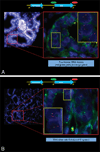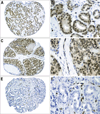Emerging critical role of molecular testing in diagnostic genitourinary pathology
- PMID: 22458900
- PMCID: PMC3449141
- DOI: 10.5858/arpa.2011-0471-RA
Emerging critical role of molecular testing in diagnostic genitourinary pathology
Abstract
Context: The unprecedented advances in cancer genetics and genomics are rapidly affecting clinical management and diagnostics in solid tumor oncology. Molecular diagnostics is now an integral part of routine clinical management in patients with lung, colon, and breast cancer. In sharp contrast, molecular biomarkers have been largely excluded from current management algorithms of urologic malignancies.
Objective: To discuss promising candidate biomarkers that may soon make their transition to the realm of clinical management of genitourologic malignancies. The need for new treatment alternatives that can improve upon the modest outcome so far in patients with several types of urologic cancer is evident. Well-validated prognostic molecular biomarkers that can help clinicians identify patients in need of early aggressive management are lacking. Identifying robust predictive biomarkers that will stratify response to emerging targeted therapeutics is another crucially needed development. A compiled review of salient studies addressing the topic could be helpful in focusing future efforts.
Data sources: A PubMed (US National Library of Medicine) search for published studies with the following search terms was conducted: molecular , prognostic , targeted therapy , genomics , theranostics and urinary bladder cancer , prostate adenocarcinoma , and renal cell carcinoma . Articles with large cohorts and multivariate analyses were given preference.
Conclusions: Our recent understanding of the complex molecular alterations involved in the development and progression of urologic malignancies is yielding novel diagnostic and prognostic molecular tools and opening the doors for experimental targeted therapies for these prevalent, frequently lethal solid tumors.
Figures







Similar articles
-
Molecular diagnostics in urologic malignancies: a work in progress.Arch Pathol Lab Med. 2011 May;135(5):610-21. doi: 10.5858/2010-0727-RAIR.1. Arch Pathol Lab Med. 2011. PMID: 21526959 Review.
-
Molecular biomarkers in urothelial carcinoma of the bladder: are we there yet?Nat Rev Urol. 2011 Dec 13;9(1):41-51. doi: 10.1038/nrurol.2011.193. Nat Rev Urol. 2011. PMID: 22158597 Review.
-
Molecular genetics and genomics progress in urothelial bladder cancer.Semin Diagn Pathol. 2013 Nov;30(4):313-20. doi: 10.1053/j.semdp.2013.11.005. Epub 2013 Nov 11. Semin Diagn Pathol. 2013. PMID: 24342287 Review.
-
[Molecular diagnostics in urologic oncology. Detection of nucleic acids in urine samples].Urologe A. 2003 May;42(5):660-8. doi: 10.1007/s00120-003-0350-3. Epub 2003 Apr 4. Urologe A. 2003. PMID: 12750801 Review. German.
-
Clinical applications of recent molecular advances in urologic malignancies: no longer chasing a "mirage"?Adv Anat Pathol. 2013 May;20(3):175-203. doi: 10.1097/PAP.0b013e3182863f80. Adv Anat Pathol. 2013. PMID: 23574774 Review.
Cited by
-
The Immunohistochemical Expression of SOX-10 in Urothelial Carcinoma and the Non Neoplastic Urothelium; and a Correlation with the Tumor Features.Asian Pac J Cancer Prev. 2022 Apr 1;23(4):1425-1432. doi: 10.31557/APJCP.2022.23.4.1425. Asian Pac J Cancer Prev. 2022. PMID: 35485705 Free PMC article.
-
Impact of immunohistochemistry-based subtyping of GATA3, CK20, CK5/6, and CK14 expression on survival after radical cystectomy for muscle-invasive bladder cancer.Sci Rep. 2021 Oct 27;11(1):21186. doi: 10.1038/s41598-021-00628-5. Sci Rep. 2021. PMID: 34707176 Free PMC article.
-
Molecular alterations associated with prostate cancer.Cent European J Urol. 2018;71(2):168-176. doi: 10.5173/ceju.2018.1583. Epub 2018 Mar 16. Cent European J Urol. 2018. PMID: 30038806 Free PMC article. Review.
-
CCL11 (eotaxin-1): a new diagnostic serum marker for prostate cancer.Prostate. 2013 May;73(6):573-81. doi: 10.1002/pros.22597. Epub 2012 Oct 11. Prostate. 2013. PMID: 23059958 Free PMC article.
-
A glance at the emerging diagnostic biomarkers in the most prevalent genitourinary cancers.Saudi J Biol Sci. 2022 Apr;29(4):2072-2084. doi: 10.1016/j.sjbs.2022.01.017. Epub 2022 Jan 15. Saudi J Biol Sci. 2022. PMID: 35531253 Free PMC article. Review.
References
-
- Mitra AP, Datar RH, Cote RJ. Molecular pathways in invasive bladder cancer: new insights into mechanisms, progression, and target identification. J Clin Oncol. 2006;24:5552–5564. - PubMed
-
- Mitra AP, Cote RJ. Molecular screening for bladder cancer: progress and potential. Nat Rev Urol. 2010;7:11–20. - PubMed
-
- Mitra AP, Cote RJ. Molecular pathogenesis and diagnostics of bladder cancer. Annu Rev Pathol. 2009;4:251–285. - PubMed
-
- Wu XR. Urothelial tumorigenesis: a tale of divergent pathways. Nat Rev Cancer. 2005;5:713–725. - PubMed
-
- Oxford G, Theodorescu D. The role of ras superfamily proteins in bladder cancer progression. J Urol. 2003;170:1987–1993. - PubMed
Publication types
MeSH terms
Substances
Grants and funding
LinkOut - more resources
Full Text Sources
Medical

